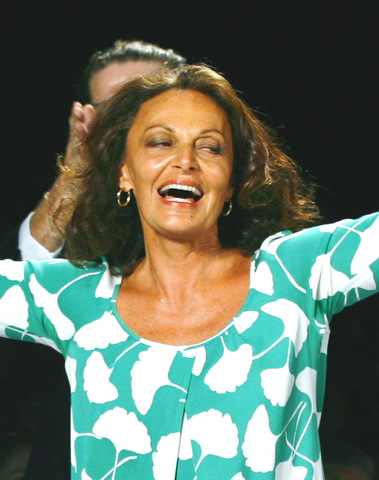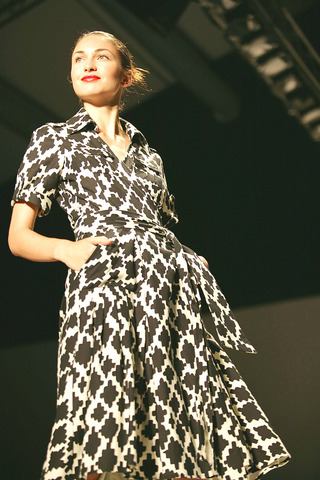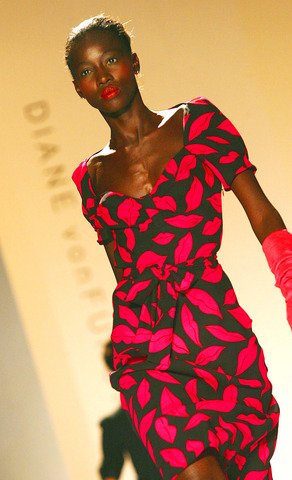Diane von Furstenberg once said her wrap dress was successful because it worked for women who loved clothes but still wanted to get stuff done. In a scrapbook, she has a page of newspaper clippings of famous women wearing the wrap dress in one year, 1976: it includes Gloria Steinem, Betty Ford, Julie Nixon Eisenhower, the actress Dina Merrill and Maureen Dean, the Watergate lawyer.
Today Von Furstenberg is wearing one of her own wrap dresses, with her glasses tucked into the V-neck. And she certainly has plenty of stuff to get done. There is one week to go until her catwalk show in New York, but she is in Paris in her role as president of the Council of Fashion Designers of America, for what she calls a "summit" with Hilary Riva of the British Fashion Council and representatives of the French and Italian fashion governing bodies, to discuss the issue of too-thin models. With the fashion show season about to begin again amid widespread unease about designers' use of skinny models, Von Furstenberg — who once commented wryly that "it will probably be on my tombstone: Here Lies the Woman Who Designed the Wrap Dress" — has what could be her best chance to alter that destiny. Being comfortable in the spotlight, she is a natural choice for an industry spokesperson. Today, in the elegant Left Bank apartment that she bought while living in the city in the 1980s, the sofas to which she guides us for our chat are situated directly beneath two large Andy Warhol portraits of the designer as a young woman.
It is already clear none of the Big Four fashion cities represented at her "summit" — New York, Paris, London or Milan — intend to follow the lead set by Madrid last season and ban skinny models from Manhattan. The Madrid ruling forbade the use of models with a body mass index of less than 18, meaning a 1.71m model would have to weigh a minimum of 54kgs to be allowed on a catwalk. Von Furstenberg is adamant that "what we need are guidelines, not rules. We need to encourage designers and agencies to be responsible. We need to make sure everyone is sensitive to the issues. But to calculate the girls' body mass — I personally think it is demeaning. I'm all about empowering women. And by lining them up against the wall and weighing them, surely you are making them feel more like meat than ever — even if it's little meat, if you know what I mean."

PHOTO: AGENCIES
There is, she says, "total agreement" between the US, British, French and Italian industries that the issue is best addressed without legislation. On Monday, the day after her show, Von Furstenberg will host a discussion panel in New York on thin models, health and body image. A nutritionist, a trainer, a model's agent and a specialist on eating disorders will speak. "As the president of the Council of Fashion Designers of America, I represent the designers. And while we can by no means take the blame for eating disorders, we can play our part in addressing this important issue." The one point on which she does intend to lay down rules is age: 14 year-olds and 15 year-olds are not uncommon on the catwalk and many feel these are often the girls most vulnerable to eating disorders. She intends to stipulate that none under 16 should appear in New York.
Von Furstenberg believes things are already improving. "I think it's great this issue has been raised. Fantastic, in fact. It's pushed a lot of people into becoming more sensitive to it. And just by being sensitive, we can improve a lot."
What does she think triggered the uproar? Are models really getting thinner? "No. I absolutely don't think they are. Twiggy was skinnier than everyone. When Jerry Hall did her first show for me, at 17, she was unbelievably narrow. The thing is, women are getting much bigger. A dress size that in the 1970s was a 12 is now a 6. So when we talk about a size zero — a few years ago, a dress that is now labeled size zero would have been labeled size 4. When I cast girls for my show, which I will be doing again in a few days, I don't see many girls who are very skinny. My samples are a size 4/6 and I don't have to adjust them to fit the catwalk girls."

But a lot of designers do use very thin models, I point out. "Do they?" she asks. Like many people who are naturally very direct, she is not particularly convincing when being disingenuous. Well, for instance, I say, at Giorgio Armani's show this week, the models were definitely bony. She gives me a look to say, you know perfectly well I'm not going to be drawn into that one. There is a pause, and eventually she says "personally ... I have always been attracted to clothes designed by women. Coco Chanel, Vionnet, Norma Kamali, Donna Karan. They have a little more — how do I put it? — understanding."
An official minimum weight would, she feels, only perpetuate the "absurd" notion of models as a physical ideal. "Most of the successful catwalk models are not very beautiful when you see them in real life. They are often quite odd-looking." Legislation about models' weight or body mass would, she thinks, feed the modern world's obsession with models, an obsession she finds ridiculous. "Modeling is a very strange and very short career. What's much more exciting and inspiring to me is that today we have a woman candidate for the presidency in France, and in the US we have a woman candidate for the presidency and a woman as Speaker of the House. Those are the things that young women should be inspired by and take confidence from."
Nonetheless, perhaps because she herself found youth and beauty no barrier to early success, she sees no contradiction in being a feminist who believes in the importance of looking good. (I recall seeing her in her New York show room once, adjusting the belt on a wrap dress: "You've got to pull it really tight," she kept saying. "See, now it's much more sexy!") She has always believed that "to look great you need a great body. I'm totally in favor of practicing yoga and climbing the stairs and eating healthy food ... . Oh, come on! It's true."

Feminine strength of will is a theme that runs through her memoir, Diane: A Signature Life. Her mother, Lily, was a survivor of Auschwitz-Birkenau and Ravensbruck concentration camps. She was 21 and weighed just 22kgs when Allied troops liberated the camps in 1945. Within six months she was married, and gave birth to Diane on New Year's Eve, 1946. "The Holocaust has shaped my character, Diane says. "I was born the daughter of a survivor, not a victim."
Von Furstenberg's extraordinary life has imbued her with a breezy attitude to achieving dreams. In her book, she recalls how as a girl, she and her friend Mireille would "play princesses." Later, the game became reality "when Mireille eloped at 17 with Prince Christian von Hannover, grandson of the Kaiser, and I married a German prince whose title dates from the Holy Roman Empire."
Having married and had children young, Von Furstenberg found her career taking off just as her marriage was falling apart. In 1976, the combined retail sales from her clothes, licenses, fragrance and cosmetic lines was US$117 million, she had made the cover of Newsweek and the front page of the Wall Street Journal. She was 29. It is perhaps a consequence of having achieved so much so young, and maybe due also to the example set by a mother who "rarely flattered me and never cautioned me," that she sees her role as being to inspire young women rather than protect them.

One of my favorite stories about Von Furstenberg is how she bought herself Cloudwalk, a farm in Connecticut, for her 27th birthday. If you do that to mark turning 27, how do you mark your 60th birthday, which she celebrated a month ago? It turns out she was rather rattled by the prospect. "Catherine Deneuve told me once she had thought she was prepared for turning 60, then when it happened it was really horrible. I never forgot that. So it was a big issue for me right up to the day itself. And then I was absolutely fine." And she smiles, and pulls her wrap dress a little tighter.


This month the government ordered a one-year block of Xiaohongshu (小紅書) or Rednote, a Chinese social media platform with more than 3 million users in Taiwan. The government pointed to widespread fraud activity on the platform, along with cybersecurity failures. Officials said that they had reached out to the company and asked it to change. However, they received no response. The pro-China parties, the Chinese Nationalist Party (KMT) and Taiwan People’s Party (TPP), immediately swung into action, denouncing the ban as an attack on free speech. This “free speech” claim was then echoed by the People’s Republic of China (PRC),

Exceptions to the rule are sometimes revealing. For a brief few years, there was an emerging ideological split between the Democratic Progressive Party (DPP) and Chinese Nationalist Party (KMT) that appeared to be pushing the DPP in a direction that would be considered more liberal, and the KMT more conservative. In the previous column, “The KMT-DPP’s bureaucrat-led developmental state” (Dec. 11, page 12), we examined how Taiwan’s democratic system developed, and how both the two main parties largely accepted a similar consensus on how Taiwan should be run domestically and did not split along the left-right lines more familiar in

Specialty sandwiches loaded with the contents of an entire charcuterie board, overflowing with sauces, creams and all manner of creative add-ons, is perhaps one of the biggest global food trends of this year. From London to New York, lines form down the block for mortadella, burrata, pistachio and more stuffed between slices of fresh sourdough, rye or focaccia. To try the trend in Taipei, Munchies Mafia is for sure the spot — could this be the best sandwich in town? Carlos from Spain and Sergio from Mexico opened this spot just seven months ago. The two met working in the

Many people in Taiwan first learned about universal basic income (UBI) — the idea that the government should provide regular, no-strings-attached payments to each citizen — in 2019. While seeking the Democratic nomination for the 2020 US presidential election, Andrew Yang, a politician of Taiwanese descent, said that, if elected, he’d institute a UBI of US$1,000 per month to “get the economic boot off of people’s throats, allowing them to lift their heads up, breathe, and get excited for the future.” His campaign petered out, but the concept of UBI hasn’t gone away. Throughout the industrialized world, there are fears that